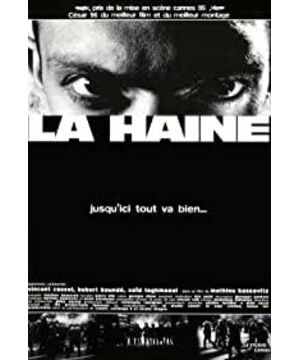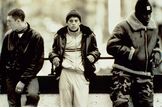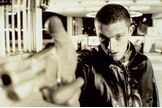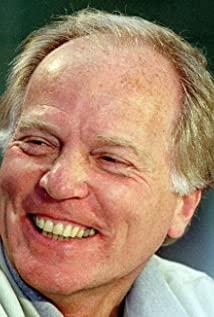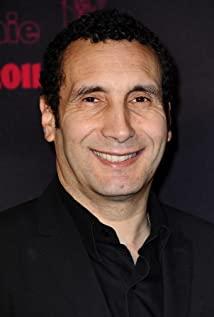It is a black and white film again, but the black and white photography is chosen not because of the age, but because of the style. In the era of color film, most of the films that re-selected black and white photography have talents in photography skills and lighting. This film is no exception. There are often large areas of shadow blocking the game until the characters in the scene are buried. Sometimes there are often exaggerated glare directly hitting the front of the characters, drawing a hideous expression. This kind of treatment is not only out of aesthetic style, but also echoes the moral of the film from the look and feel-the three protagonists in the film toss and turn between two different hells, and then they are caught.
The film's mirror movement also continued the more significant French habits, and the photographic style that prefers long shots and the well-designed scene scheduling are indispensable. In this respect, the classic French style is very different from the classic Russian style. Compared with the montage theory, French filmmakers seem to be more inclined to scene scheduling. The French believe that relying on scene scheduling instead of a large number of post-editing can make the movie look more real, smoother, and more easily give the audience an immersive feeling. In addition, the extensive use of long lenses inevitably requires the camera itself to be in constant motion, which intensifies the sense of space in the film.
Specifically, in this film, portable cameras are widely used to produce motion effects. In a fixed-camera scene, the "Brownian motion" of the characters in the picture is maintained. This design not only makes the film more visually appealing, but also facilitates the expression of the film’s emotions. The dazzling movement appropriately reflects the anxiety and anxiety of the protagonist's youth.
The film unfolds against the backdrop of youth riots in the suburbs of Paris. It also opened with a stunningly famous monologue in the history of French cinema: "There was a man who committed suicide. He jumped from the 50th floor and comforted himself every time he dropped: So far, everything is fine. So far, everything Everything is good. So far, everything is good....
But the important thing is not the process of falling, but how to land."
Three idle young people on the outskirts of Paris used drugs and fights to vent their excess energy. During the riot, their friends were severely injured by the police, so they decided to retaliate. The movie starts at 10:38 one morning and ends at 6:01 the next morning. The camera followed the three people like a ghost, recording the 19 hours and 23 minutes of the story.
The protagonist Vince found a policeman's pistol in the chaos, so his life was inevitably changed. For him, the pistol is a great power. It can give Vince a lot of confidence, can make him respond, can scare off the gangsters who besie him, can retaliate against the police. It is precisely because of this that it controls Vince's mind and makes Vince increasingly desire to use a pistol to solve problems. At this level, the pistol resembled Frodo's ring.
So this story is doomed to a devastating ending when it begins.
The name of the movie is "Hate". In fact, I think hatred is just an excuse. The characters in the film are more motivated by inner anxiety. They cannot find their place and future. The gymnasium that Huber had worked so hard to manage for two years was burned down, and Shayd's attempt to associate with the girl he liked turned into a quarrel because he was too impatient. Vince couldn't buy the spices his grandmother needed because of one dollar less. What they face is a lack of understanding, patience, and compassion. In fact, Vince also participated in the riot that burned down the Bell Stadium. This behavior was not due to hatred, but a kind of madness outside of hatred. The anxiety about one's own existence, as Vince said: "I feel like an ant lost in the universe." Such anxiety is constantly strengthened by environmental conditions. It's like the story told by that strange little man in the bathroom: When we ask ourselves, we always make a mistake. The question is not whether we believe in God, but whether God believes in us. When their beliefs also become anxious, they can only face a violent revolution, both to others and to themselves.
When news came that his friend was seriously injured and died, Vince decided to kill a policeman to avenge him. Hu Beier was fiercely opposed. After experiencing a real experience, Vince handed the pistol to Hu Beier, and he was relieved at that moment. But the pistol has already met the curse of fate. The Buddha said: All the present is doomed by the future. Everything can't look back.
As mentioned earlier, the film’s photography and soundtrack accurately convey the emotions of the film. The strong movement implies the anxiety of the characters, while the few static shots indicate the profound blankness of the characters in a calm state. Of course, this style just continued the tradition of French cinema and did not make any special breakthroughs. However, the photographer has some methods that are worth learning from in the processing of turning panoramic shots into large close-ups. His method is to let the story or dialogue continue to take place in the depth of field of the picture, while a character slowly walks towards the camera, so that without zooming or blunt editing, we get a clear close-up in the foreground. In the dialogue scene, you do not need to move the lens, but use the refraction of a mirror to express the facial emotions of the two parties in the dialogue. This method is also effective.
This production idea of avoiding excessive editing continues until the end of the movie. The end of the film is the final climax of the film. What is commendable is that the director handled it very simply. This 134-second scene has 10 shots in total, with a picture of a real event inserted in the middle. It rendered the tense atmosphere and continued the overall style of the movie. In the last shot, Vince was accidentally shot. Hubert and a policeman pointed their pistols at each other's heads. The film begins with Shayid's close-up and ends here. The final ending of the film is no longer important, just like the voice-over sounded again at the end of the film: "This is a story of social degradation. We keep saying to ourselves: So far, everything is fine. So far, everything is fine.... "
View more about La Haine reviews


